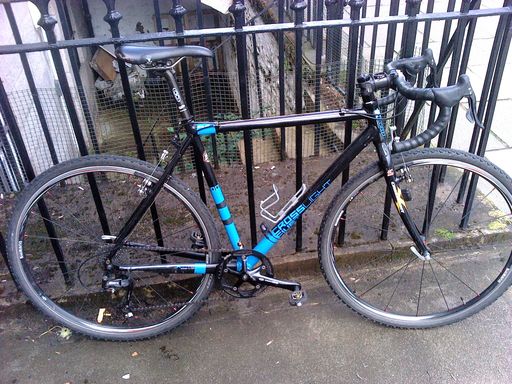I went cyclocross racing in 2010. I’d broken my arm badly while cycling home from a party one night a couple of years earlier, and some kind of overdeveloped “HONESTLY, I’M FINE” reflex had transformed me in the intervening period from an enthusiastic cycle commuter into a cyclocross bore who knew everything about the sport except how to race. I lapped my local park over and over; I dismounted and remounted until my perineum cried out “no more”; and, most of all, I obsessed over my bike.
Cyclocross is great for this. Cyclocross in 2010 was even better. Disc brakes were making waves in amateur races and the UCI was about to make them legal at the top levels of competition. Serious racers rode tubular tyres but tubeless was gaining ground. Best of all, 1× – a favourite of cyclocrossers, meaning one chainring and one shifter only – was still a DIY affair. No CX1 or Rival 1 groupsets yet: if you wanted a 1× set-up, it was up to you to do it. These were the avenues down which a bike nerd might joyously lose themselves.
Lack of money limited just how experimental I could get, and eBay was my friend. Instead of disc brakes, I plumped for Empella Froggleg cantilevers, a set of brakes adjusted primarily by bending them with a big spanner. I went for plain old clinchers rather than tubeless tyres. And, most importantly, I cobbled together a 1× drivetrain using the cheapest components I could lay my hands on – while still retaining a modicum of élan, of course. This meant Shimergo all the way.

What is Shimergo?
The word itself is a mash-up of “Shimano” and “Ergopower”, the latter of which is Campagnolo’s name for its integrated brake/shifter levers. What Shimergo means in practice is that it’s possible to mix and match drivetrain components from Shimano, Campagnolo, SRAM and other manufacturers to save weight or money, or, if you’re lucky, both. Add 1× to the mix and you shed yet more weight and save yet more money. As a tight-fisted bike nerd with delusions of cyclocross grandeur, I found it impossible to resist.
How does it work?
Before we start, it’s worth mentioning that because we’re talking about 1× set-ups, what follows relates to rear shifting only. It’s possible to put together a Shimergo set-up for front derailleurs but I haven’t ever done so. With that out of the way, let’s get to how Shimergo works.
In any derailleur system with indexed shifting, when you change gear the shifter retracts or extends a certain amount of cable per click. Change towards a larger sprocket on the cassette and the shifter pulls in the cable; change towards a smaller sprocket and the shifter releases it. For most shifters, the amount of cable is the same per click – but more on that later.
Now, this movement of the cable causes the rear derailleur to move inwards or outwards by a set distance, as determined by the amount of cable pulled or released by the shifter in conjunction with the derailleur’s cable pull multiplier. For example, in a 9-speed Shimano groupset,
- the shifter pulls or releases 2.5mm of cable per click
- the derailleur multiplies shifter cable motion by 1.7, and
- the centrelines of each adjacent pair of sprockets are 4.35mm apart.
Putting this together, derailleur movement per cable click is around 2.5mm × 1.7 = 4.25mm, which is just 0.1mm different to the sprocket spacing. Across a complete 9-speed cassette, if the derailleur is perfectly aligned with the smallest sprocket, that’s a cumulative error of just 8 shifts × 0.1mm = 0.8mm – that is, the derailleur will be less than 1mm out of alignment with the largest sprocket. And if Shimano is happy with a 0.8mm margin of error, you should be too.
Given all this, the trick is to choose a shifter, derailleur and cassette so that the derailleur’s movements as actuated by the shifter match the spacing of the rear sprockets as closely as possible. There are lots of possible combinations here: a 9-speed Shimano derailleur and cassette with a 10-speed Campagnolo shifter, as I used; an 11-speed cassette from any manufacturer with an 11-speed shifter and derailleur from any another; a 10-speed Campy shifter and a 10-speed SRAM derailleur on a 10-speed Shimano or SRAM cassette; and so on.
A 1×9 Shimergo set-up
For my ’cross bike, I settled on a 1×9 setup using a 10-speed Campy shifter with a 9-speed Shimano derailleur and cassette. In the event, the finished bike did not exactly live up to my vaulting ambition, even if it did rock Campy’s svelte and sinous brifters rather than Shimano’s lumpen counterparts. Witness the mismatched frame and fork! The taped-over bottle bosses! The questionable cable routing! But if the bike was aesthetically challenging, its drivetrain worked like a dream. Simple, cheap and reliable – with a few caveats.

The maths worked out like this:
- the 10-speed Campy shifter pulls or releases 2.83mm of cable per click,
- the 9-speed Shimano derailleur multiplies shifter cable motion by 1.7, and
- the centrelines of each adjacent pair of sprockets are 4.35mm apart.
Thus, derailleur movement per cable click is 2.83mm × 1.7 = 4.81mm.
Wait, what?
4.81mm per shift is very different to the 4.35mm spacing of the sprockets. The key to making this particular set-up work is to use “Hubbub” cable routing, in which the shifter cable is clamped to the derailleur at a slightly different angle, thereby changing its multiplication ratio. (Cyclocross Magazine have a good photograph of Hubbub cable routing.) This changes the derailleur’s ratio to approximately 1.6 and, with that tweak, my derailleur’s movement per cable click became 2.83mm × 1.6 = 4.53mm. Relative to the sprocket spacing of 4.35mm, this produces a cumulative error of just 8 × (4.53 - 4.35)mm = 1.44mm across the whole cassette. In practise, it turns out, this is perfectly fine.
Now, there’s another wrinkle here, in that Campagnolo’s 10-speed shifters actually pull a slightly different amount of cable per shift, with more cable pulled towards the larger sprockets. From the smallest sprocket to largest, cable pulls in millimetres are: 2.5, 2.5, 2.5, 2.5, 2.5, 3.0, 3.0, 3.5, and 3.5, averaging out at 2.83mm. (Shimano’s 8- and 9-speed shifters, Shimano’s 10-speed MTB shifters and Campy’s 11-speed shifters all have the same quirk.) For what it’s worth, I’ve used Campy 10-speed shifters both with a 9-speed Shimano derailleur (as described here) and a 10-speed “Exact Actuation” derailleur from SRAM. Get your indexing right and you shouldn’t have a problem.
There’s one last thing to be aware of. Because my shifter was designed for 10 sprockets but the cassette only has 9, I used the “L” derailleur limit screw (“L” for “low”) to stop the shifter pulling the chain off the largest sprocket and into the spokes. It’s easy enough to do: having connected the cable and adjusted the indexing, set the “L” screw as normal to prevent the derailleur from moving any further. When you get to the innermost sprocket and try to shift again, the shifter lever won’t let you.
Here’s my complete set-up:
| Component | Model | Notes |
|---|---|---|
| Frame | Kinesis Crosslight 5T | |
| Shifter | Campagnolo Xenon 10-speed | “Quick-Shift” mechanism |
| Derailleur | Shimano Deore RD-M591 (9 speed, long cage) | “Hubbub” cable routing |
| Cassette | Shimano Deore HG61 (9 speed, 11-28) | |
| Crankset | Shimano 105 FC-5501 (53/42 double) | 53t chainring removed |
| Chain retention | Salsa Crossing Guard (44t x 130mm) + Deda Dog Fang |
This set-up withstood three cross races with only one dropped chain and did sterling duty as a commuting bike for many years afterwards – until it didn’t. It’s relatively well documented that the escape mechanism in Campy’s low-end Xenon shifters eventually wears out, which is exactly what happened to mine. Having shifted up the cassette to a larger sprocket, the shifter would sometimes fail to “catch” and would drop back down to a lower cog. I replaced them with Veloce shifters instead, which solved the problem. And that’s where I’ve been ever since: I’ve since added SRAM components to the mix, but I’ve been happily running 1×9 or 1×10 Shimergo drivetrains for the past decade.
Many people far more qualified than me have written in detail about mixing drivetrain components and so, rather than recapitulate what has been said before, below are some links to point you in the right direction.
- A guide to rear shifting at Cycling UK. A good summary of the Shimergo concept.
- Bicycles/Maintenance and Repair/Gear-changing Dimensions on WikiBooks. Use the numbers here to come up with your own Shimergo combinations.
- Science Behind the Magic | Drivetrain Compatibility at Art’s Cyclery. A comprehensive guide to the concepts and numbers behind Shimergo.
- Shimano and Campagnolo - Can’t We All Get Along? from Cyclocross Magazine. Focuses on 8- and 9-speed set-ups for ’cross racing.
- Can you run Campy shifters with a SRAM drivetrain? Sure, why not? from the esteemed Leonard Zinn at VeloNews. Describes a 10-speed “Sramergo” set-up that combines 10-speed Campy shifters with a 10-speed SRAM derailleur.
- Drivetrain compatibility hidden in plain sight - another from Leonard Zinn at VeloNews, this time describing how 11-speed cassettes from Campy, Shimano and SRAM are interchangeable.